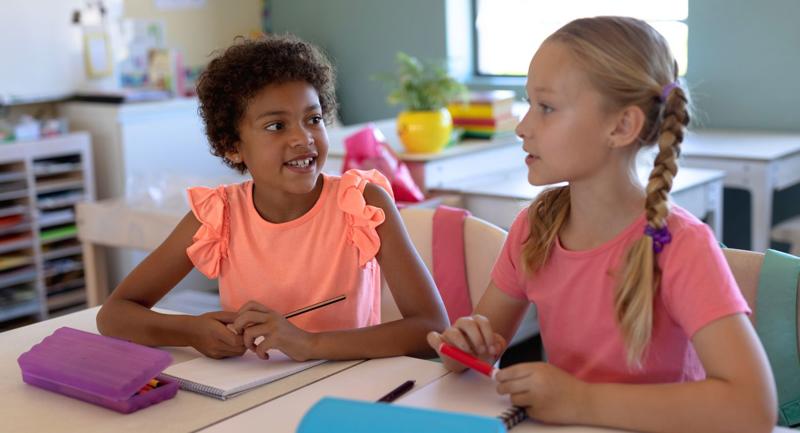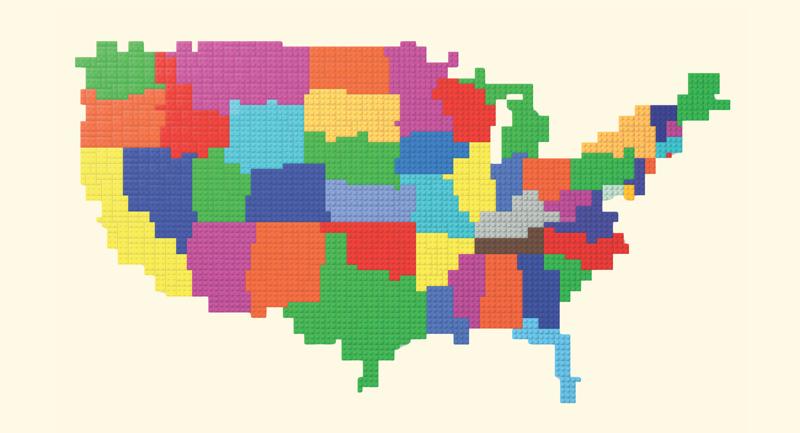Fifth graders were busy writing acrostic poems on small posters. One girl wrote a school spirit poem, with the first letter of each line spelling out the school name: S for "super," N for "nice," and so on. She even drew a picture of a bobcat (pictures were not required) that was a spot-on replication of the school mascot. A boy wrote an acrostic poem with the first letter of each line spelling out his name: A for "agressive" (unfortunately spelled incorrectly); N for "nutty"; and so on. No picture.
So what kind of feedback did the teacher give? Her comments gave students the impression that the girl's poem was perfect and that the boy's poem was not so good, mostly because of that one misspelled word and the fact that his lines sloped downward on the poster.
This assignment was a giant missed opportunity for both students. The girl's work was a skillful replication of things she'd seen before. All the words were simple, the school spirit theme was a common one, and the point of her drawing was to duplicate the school mascot. She needed to know that her work was proficient—but she also needed to be challenged to work with more originality when writing poems. She only received half that feedback.
The boy's work was more original. Although the poem was only five lines long, it gave readers a real sense of who he was—or, at least, how he saw himself. He needed to know that he had used a prescribed format creatively—but he also needed to be challenged to check his spelling and use a ruler to make straight lines of text on posters. He, too, only received half that feedback.
What was missing in the teacher's feedback is easy to diagnose—her criteria for success were too limited—but it's harder to put right. Can creativity be an assessment category? If so, how do you handle it? Surely you wouldn't downgrade the girl's perfectly good poem, beautifully and dutifully written and presented.
Here's how to assess and give feedback about creativity and, in the process, help students become more creative in their work.
What Is Creativity?
Creativity is a simple concept that can be difficult to get your head around. In its most basic sense, creative means "original and of high quality" (Perkins, 1981, p. 6). The girl's school spirit poem was of high quality, but it was workmanlike and derivative. The boy's self-analysis poem was original, and the poetic composition and word choice were fine; he just needed to attend to the quality of the mechanics. Of course, a poem that is uninterpretable or meaningless, no matter how original, can't be creative.
What does it look like when schoolwork is original and of high quality? Probably the foremost characteristic of creative students is that they put things together in new ways (Brookhart, 2010). For example, while writing a poem about a sunset, a student who observes that moment when the sunset looks very much like a sunrise and makes the connection to other endings that can also foreshadow beginnings is more creative than a student who describes that moment as "red and fiery."
Students who are able to put things together in new ways can observe things others might miss, construct more novel products, give more novel performances, use more unusual or unconventional imagery to make points, observe ordinary things and find in them an area to wonder about or a problem to solve, and the like.
Not all schoolwork, even performance assessments, supports this sort of thinking. Before you can assess creativity, you need to make sure that the tasks you set for students are conducive to creativity.
Stimulating Creative Thinking
Myriad opportunities for fostering creativity are right under our noses in school, because learning is a generative act. However, what's missing in many classrooms is deliberately noticing and naming opportunities for creativity when they occur, giving feedback on the creative process, and teaching students that creativity is a valued quality.
Brainstorming in any subject can be a creative activity. Elementary teachers who ask students to begin the writing process with a graphic organizer, list, or outline can give feedback on the originality of the ideas as well as their suitability for the writing assignment. For example, an elementary teacher might ask students to list several farm animals, imagine a funny situation that might happen to each, and then pick one animal and write a story about it.
Science teachers who have students brainstorm a list of hypotheses to test can give feedback on the originality of ideas as well as their suitability for the experiment that the students will design. For example, a teacher might mention that her coffee cools too quickly in the cup and then ask students to brainstorm a list of things that might slow down the cooling process, write a hypothesis about each one, and design an experiment to test one hypothesis.
Assignments that require students to produce new ideas or reorganize existing ideas in a new way are likely to foster student creativity. In mathematics, asking students to identify a problem for which multiplication would be useful in finding the solution requires more creativity from them than giving students a multiplication word problem to solve. Similarly, in music, an assignment in which students write an original melody requires more creativity than one in which they analyze a preexisting melody.
Assignments that require students to put two things together are also likely to promote creativity. For example, in English language arts, asking students to write or speak about how The Adventures of Tom Sawyer would have been different had Huckleberry Finn been the main character sparks more creativity than asking students to discuss the character of Tom Sawyer. In social studies, asking students how the events that led up to World War I might be handled if they happened today fosters more creativity than asking students to discuss the causes of World War I.
Students will still exhibit a range of originality and quality in their work, even in response to these more creative prompts. Teachers can give feedback on both of these aspects of the work.
Sometimes teachers and students think that any assignment that allows student choice is conducive to creativity. Although that may be true in general, only assignments that allow student choice in matters related to what the student is supposed to learn develop student creativity in the area under study. For example, if you ask students to compare characters in two novels and allow them to choose the characters or novels, they have the opportunity to develop creativity in their approach to literary criticism. However, if you ask students to compare two specified characters and just give them choices about whether they want to write an essay, give a speech, or write a song, students will not have that opportunity.
Criteria for Creativity
Creativity is not a synonym for clever, humorous, artistically pleasing, enthusiastic, or persuasive. Those are all great qualities that we can assess in their own right, but we shouldn't confuse them with creativity. As early childhood educator Lilian Katz once railed, "Creativity is not animals with long eyelashes!"
Rather, criteria for creativity should match what we expect in creative work: originality and high quality. Creative students
Recognize the importance of a deep knowledge base and continually work to learn new things.
Are open to new ideas and actively seek them out.
Find source material in a wide variety of media, people, and events.
Organize and reorganize ideas into different categories or combinations and then evaluate whether the results are interesting, new, or helpful.
Use trial and error when they are unsure how to proceed, viewing failure as an opportunity to learn. (Brookhart, 2010, pp. 128–129)
The first four characteristics lead to qualities in the work that we can observe, assess, and provide feedback on. For example, are the source materials varied? Are ideas organized in a fresh way and uniquely suited to the problem or product? The last characteristic—using trial and error—is about the student's approach to learning and may or may not show itself in the finished work.
A Rubric for Creativity
If all of these first four characteristics are in play in an assignment, then a rubric like the one in Figure 1 (p. 31)may support teachers and students in assessing creativity (Brookhart, 2013). The rubric describes four levels of creativity—very creative, creative, ordinary/routine, and imitative—in four different areas—variety of ideas, variety of sources, novelty of idea combinations, and novelty of communication.
FIGURE 1. Rubric for Creativity
Assessing Creativity - table
| Very Creative | Creative | Ordinary/Routine | Imitative |
|---|
| Variety of ideas and contexts | Ideas represent a startling variety of important concepts from different contexts or disciplines. | Ideas represent important concepts from different contexts or disciplines. | Ideas represent important concepts from the same or similar contexts or disciplines. | Ideas do not represent important concepts. |
| Variety of sources | Created product draws on a wide variety of sources, including different texts, media, resource persons, or personal experiences. | Created product draws on a variety of sources, including different texts, media, resource persons, or personal experiences. | Created product draws on a limited set of sources and media. | Created product draws on only one source or on sources that are not trustworthy or appropriate. |
| Combining ideas | Ideas are combined in original and surprising ways to solve a problem, address an issue, or make something new. | Ideas are combined in original ways to solve a problem, address an issue, or make something new. | Ideas are combined in ways that are derived from the thinking of others (for example, of the authors in sources consulted). | Ideas are copied or restated from the sources consulted. |
| Communicating something new | Created product is interesting, new, or helpful, making an original contribution that includes identifying a previously unknown problem, issue, or purpose. | Created product is interesting, new, or helpful, making an original contribution for its intended purpose (for example, solving a problem or addressing an issue). | Created product serves its intended purpose (for example, solving a problem or addressing an issue). | Created product does not serve its intended purpose (for example, solving a problem or addressing an issue). |
I created this rubric with some trepidation—because where there's a rubric, there will be someone who's thinking of using it to grade. Generating a grade is not the intended purpose of the rubric for creativity. Rubrics help clarify criteria for success and show what the continuum of performance looks like, from low to high, from imitative to very creative. For that reason, rubrics are useful for sharing with students what they're aiming for, where they are now, and what they should do next. I do not recommend grading creativity.
Another advantage of the rubric for creativity is that it functions as a visual organizer that makes us consider creativity apart from the other criteria for the work. For example, in the acrostic poem assignment, other criteria might include the quality of the ideas conveyed, word choice and use, and correct application of the acrostic format. There's more opportunity for creativity in some criteria (ideas) than in others (using the acrostic format properly), so creativity is not entirely separate from the quality of the work. Still, taking a step back from the work and focusing on its creativity allows for the kind of feedback missing in those opening classroom examples.
Giving Feedback on Creativity
As you might expect with such a broad concept as creativity, there's no single formula that will always work. Start by helping students understand what creativity is, using rubrics, examples, and discussion about these. Then give feedback on the level of creativity you observe in their work. In the example of the acrostic poem, the teacher might have coached the girl to work with more originality, explaining that her work was very much like many other poems and challenging her to write a poem that was less like those of others. The boy needed to know that his use of unique personality terms—such as aggressive and nutty—was creative and poetically skilled. In these cases, a few words of feedback to each student would probably have sufficed. The important thing is to say the words—to name, note, encourage, and value the creativity in the work.
Teachers can give more complex feedback on more complex assignments. For example, in the write-a-melody music assignment, some melodies will sound very much like themes that other composers have written. Pointing out those similarities and asking for more differences may be useful. ("This part of your melody sounds a lot like the beginning of 'The Star Spangled Banner.' Were you thinking of that? Can you put together a series of four notes that work as a melody but that don't sound like anything else you've ever heard?")
Just as with all feedback, students need an immediate opportunity to use feedback on creativity. They don't necessarily have to redo their work, although that's one way to give them such an opportunity. They could also brainstorm fresh ways they might have approached the problem, written the poem, and so on. But they need to do something with the feedback immediately. Minds need to stretch to grow more creative.
Putting It All Together
Elaine Shaffer is a 3rd grade teacher at West Hills Primary School in West Hills, Pennsylvania. Her students were learning to identify polygons and understand their characteristics. She gave them an assignment to draw a picture using polygons. The assignment was conducive to creativity because it asked students to put together two unlike things—their knowledge of polygons and their view of the world in which they live. Ms. Shaffer shared three criteria for the picture with her students: (1) There should be at least four different polygons, (2) the polygons should be labeled, and (3) the polygons should form a picture.
Look at Expectations
Let's examine two pieces of student work in terms of these teacher expectations (see fig. 2). Student 1 included and labeled four different polygons, and she created a picture, as opposed to just including four separate shapes. So her work was of high quality. Student 2 included at least three polygons (a square, a trapezoid, and a rectangle). He created a picture, but he didn't label anything. Looking at his work, we can tell he understood that polygons have straight sides, but it's unclear whether he knows their names. Perhaps he just forgot to label them. His work was of lesser quality than that of Student 1, although if he does know the names of the polygons, his understanding is of high quality. A good next step would be for the teacher to ask him whether he knows the names of the polygons he used and, if so, to ask him to label them.
FIGURE 2. Student Polygon Drawings
Look at Creativity
Now let's focus on creativity separately from the other criteria for the work. The rubric for creativity suggests that we can look for four things—variety of ideas and contexts; variety of sources (including personal experiences); whether the author has combined ideas to make something new; and whether he or she has communicated something interesting or surprising.
Student 1 uses ideas that are standard in children's drawings: a neighborhood scene with a house, a path, a tree, and so on. The picture looks similar to many other children's drawings. The creativity in Student 1's work is derived from the assignment, which required students to combine polygons and a picture.
Student 2 uses polygons and creates a picture, incorporating two new ideas: baking and football. That caused me to smile when I first saw this drawing. I'm not used to seeing football, baking, and polygons together. In terms of creativity, his work was more original than Student 1's picture. In fact, although it may be pressing too hard, I think I see a young man who has a good relationship with his mom and who likes to bake—or, at least, likes to eat what his mom bakes. The picture draws the viewer in and invites such speculation, which is part of its "original contribution" or surprise value.
I'm not saying that the boy doesn't need to know the names of his polygons or that his teacher should regard his work as evidence of this knowledge. I'm saying that when teachers appraise creativity separately, additional opportunities for feedback arise. If the teacher tells Student 2 how engaging and original his picture is, she will encourage his continued creativity. If he only hears that he's missing some labels, he will not know the complete value of the work he produced.
Helping Your Students Grow
Teachers can assess creativity at every grade level and in every subject, using both basic and complex student work. Think through an example of an assignment you might give in the grade level and subject you teach. How will your feedback help students grow more creative? And how will you assess their progress?
EL author Susan Brookhart talks with EL Senior Associate Editor Amy Azzam about how to assign and assess creative tasks.
<P ID="brookhart-audio">BROOKHART AUDIO/VIDEO HERE<!--http://bcove.me/f0vg71wr http://video.ascd.org/services/player/bcpid18377529001?bckey=AQ~~,AAAAAmGjiRE~,escbD3Me8-wT_coVb7sTe18vG6vv3Oyk&bctid=2093731625001vcm code:--><!-- Start of Brightcove Player --><!--div style="display:none"></div--><!--By use of this code snippet, I agree to the Brightcove Publisher T and C found at https://accounts.brightcove.com/en/terms-and-conditions/. --><!--<object id="myExperience2093731625001" class="BrightcoveExperience"> <param name="bgcolor" value="#FFFFFF" /><param name="width" value="570" /><param name="height" value="380" /><param name="playerID" value="18377529001" /> <param name="playerKey" value="AQ~~,AAAAAmGjiRE~,escbD3Me8-wT_coVb7sTe18vG6vv3Oyk" /> <param name="isVid" value="true" /><param name="dynamicStreaming" value="true" /><param name="@videoPlayer" value="2093731625001" /> </object>--><!-- This script tag will cause the Brightcove Players defined above it to be created as soonas the line is read by the browser. If you wish to have the player instantiated only afterthe rest of the HTML is processed and the page load is complete, remove the line.--><!-- End of Brightcove Player --><!-- html code: --><!--<object id="flashObj" width="570" height="380" classid="clsid:D27CDB6E-AE6D-11cf-96B8-444553540000" codebase="http://download.macromedia.com/pub/shockwave/cabs/flash/swflash.cab#version=9,0,47,0"><param name="movie" value="http://c.brightcove.com/services/viewer/federated_f9?isVid=1" /><param name="bgcolor" value="#FFFFFF" /><param name="flashVars" value="videoId=2093731625001&playerID=11490813001&playerKey=AQ~~,AAAAAmGjiRE~,escbD3Me8-zfW2J4SI2ZSHPsqtup23tT&domain=embed&dynamicStreaming=true" /><param name="base" value="http://admin.brightcove.com" /><param name="seamlesstabbing" value="false" /><param name="allowFullScreen" value="true" /><param name="swLiveConnect" value="true" /><param name="allowScriptAccess" value="always" /><embed src="http://c.brightcove.com/services/viewer/federated_f9?isVid=1" bgcolor="#FFFFFF" flashVars="videoId=2093731625001&playerID=11490813001&playerKey=AQ~~,AAAAAmGjiRE~,escbD3Me8-zfW2J4SI2ZSHPsqtup23tT&domain=embed&dynamicStreaming=true" base="http://admin.brightcove.com" name="flashObj" width="486" height="412" seamlesstabbing="false" type="application/x-shockwave-flash" allowFullScreen="true" swLiveConnect="true" allowScriptAccess="always" pluginspage="http://www.macromedia.com/shockwave/download/index.cgi?P1_Prod_Version=ShockwaveFlash"></embed></object>-->








